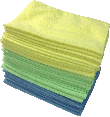If you have ever been faced with an insect infestation, then you know just how useful a tool bug bombs can be. That being said, this useful tool can be a huge frustration when it comes time to clean up what is left over. After all, the insecticide fog can—and does—get everywhere. Here are a few different methods to help clean up that nasty residue quickly.
- Type of bomb. There is more than one type of bug bomb or fogger available for use. Some bug bombs are supposedly able to be used without worrying about any of the left-over residue. That being said, prior to using any bomb or fogger, make sure you pay special attention to the directions and follow them without fail. Prior to using any of the bug bombs, make sure you have covered anything that you may later ingest—this is a poison after all, and it's better to be safe than sorry.
- Air out the house. Once you have waited the requisite amount of time before you reenter the house, the first thing that you need to do is let the house air out. Open a few windows on each floor of your home to allow extra air flow so that you can breath a little easier. Allow things to air out for roughly another hour as you continue to remove the residue from the other parts of the home.
- Wipe everything down. Using a wash rag and warm soapy water, wash down every surface in your home. This means everything from your television to your bookshelves, your kitchen table to the counters. Everything needs to be washed or wiped down. This prevents accidental ingestion or prolonged contact to something that did just kill a bunch of living organisms, after all.
- Wash. Everything that can be washed needs to be. Focus primarily on the rooms that are going to see the most traffic like the living room, kitchen, and any bedrooms that are currently in use. Wash all your plates, glasses, silverware, and anything else that you use to eat with that may have been exposed to the insecticide. Also wash the sheets, bedspreads, and curtains to make sure that you don't sleep in that junk.
- Vacuum or mop. Finally, you need to either vacuum or mop the flooring of your home. Do this as many times as is necessary to remove all traces of the insecticide. On average, this is going to be three or four times. When mopping your floor, make sure that you use the proper cleaner, but for the most part warm soapy water will do the trick.
Author Bio
Lee Wyatt
Contributor of numerous Tips.Net articles, Lee Wyatt is quickly becoming a regular "Jack of all trades." He is currently an independent contractor specializing in writing and editing. Contact him today for all of your writing and editing needs! Click here to contact. Learn more about Lee...
Adding an Extra Phone Jack
Adding a phone jack does not have to be a stressful or expensive process. In fact, it is something that any beginner ...
Discover More
How Much Is My House Worth?
If you have been living in your house for a while, or you are just simply curious, then you might be wondering "How much ...
Discover More
Cleaning Nicotine Stains From Appliances
Just because someone has quit smoking doesn't mean that they are finished with all the complications of smoking. Years of ...
Discover More
Office Cleaning Services
It can be difficult to keep up with the cleaning responsibilities in your office. Instead of trying to do it all, think ...
Discover More
Domestic Cleaning
Do you ever wish you had some help getting things done around the house? Domestic cleaning services may be able to assist ...
Discover More
Cleaning Glass Tables
Because glass tables don't hide any amount of dust, grease or grime, you'll need to clean them often. Here are three easy ...
Discover More

Comments